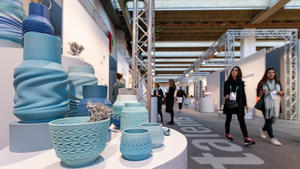A news flash that will surprise no one: The industry is changing, and fast. Direct-to-consumer furniture companies are offering custom upholstery at cut-rate prices. Online engines like Homepolish and Décor Aid are bringing design to new audiences. Print is dying, Instagram is rising, and giants are stumbling. Looking at the turmoil, Chad Stark, senior vice president of his family’s business, Stark Carpet, as well as president of Scalamandré, takes a glass-half-full mindset: “I believe to my core there’s more opportunity today than there’s ever been in the history of the world, especially in our industry,” he tells Business of Home. But there’s a catch: You have to innovate.

In a CEU talk Stark is giving at next week’s Spring Market day at New York’s Decoration & Design Building, he’ll outline what he sees as the core threats to interior designers’ businesses, as well as a few ideas on how to deal with them. It’s a presentation Stark has been giving for the past three years to designers all over the country. The details have changed a bit over time, but the core premise has remained the same: It’s not just the big bad internet that’s changing everything; the design business itself is built on shaky ground.
“The biggest threat to any business is not being customer-centric. [Home video rental company] Blockbuster failed because 12 percent of their revenue came from late fees—what I call ‘bad profit,’ because it’s against the best interests of the customer,” says Stark. “Our industry was built against the best interests of the customer because it was all secret and exclusive. That’s not tolerable anymore.”
As a result of technological, generational and economic forces, Stark believes that customers of the future won’t stomach opaque pricing, and that designers would be well-served to focus less on their access to exclusive product, and more on their creative and managerial skills. It’s a concept most designers have probably brushed up against, but old habits die hard. “Everyone’s scared of losing what they have. In an effort to protect it, they don’t innovate—and lose the opportunity [as a result],” says Stark. “The way people made tens of millions of dollars in the 1970s, ’80s and ’90s won’t be the way they make tens of millions of dollars in the future.”
He’s not speaking academically. Since joining the family business in 2012, Stark has been on a quest to push innovation. Over time, he’s experimented with ways that his companies can reach new audiences while still maintaining core protections for the trade. “We’re adapting to the same things. Everything I say [to designers] is true of our leadership team as well,” he says. “We’ve made our mistakes, but the only way to make great decisions is to learn from bad ones. Part of the mindset for innovation is playing to win versus not playing to lose.”
Stark doesn’t pretend to have all the answers, but he urges designers to try new things, and to consider new pricing models. He says that since he began giving the talk, the industry’s changes have become more and more visible—and his audiences have grown more receptive. Still, the need to adapt can be a tough pill to swallow for some. “It’s an emotional presentation. If people leave feeling overwhelmed, I can understand that,” says Stark. “But it’s better than feeling complacent.”
The CEU talk “Knowledge Is Power When Information Is Everywhere: How to Thrive in the New Design Economy” takes place on May 22, from 11:10 a.m. to 12 p.m., at Stark’s showroom in the Decoration & Design Building (979 3rd Ave., Suite 1102). To attend, register here.




























